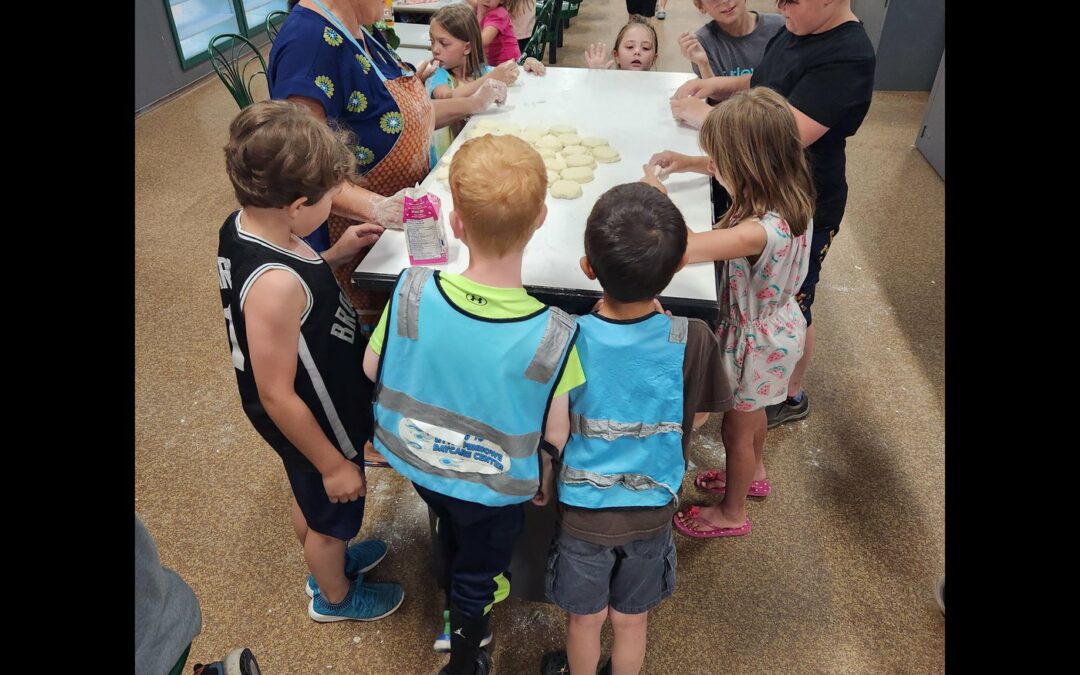By Carol Baldwin, Local Journalism Initiative Reporter
The first cultural learning afternoon for attendees of the 2024 Kids Club in Wakaw was held on Wednesday, July 10. Forty-three young people learned about bannock making and the ribbon skirt from Val Gaudet, a citizen of Batoche Homeland of the Metis Local #51. Val shares her knowledge and skills regularly at special events designed to acquaint people with Metis history and culture.
Dwane Burke, Recreation & Community Development Manager, with the Town of Wakaw, asked the children, “How many of you have had Bannock?” Roughly half raised their hands, and nearly half of those again asserted they had made it. Although the Metis culture is one of the historic cultures of the area, with intra- and interprovincial migration and international immigration, significant numbers of children are still unfamiliar with it.
It is conventionally believed that Scottish fur traders called Selkirk settlers introduced Bannock to the Indigenous peoples of North America during the 18th and 19th centuries. Bannock became a staple for voyageurs, fur traders, prospectors, and later, Indigenous peoples as a quick and simple carbohydrate-rich food. In its most basic form, it is made of flour, water, and lard (or shortening). There are different ways of making it and depending on the recipe milk, salt, sugar, and baking powder are sometimes added.
The ribbon skirt is another recognizable representation of Indigenous culture. Coloured silk ribbons were first introduced to the Indigenous peoples by French and English traders, and were subsequently adopted into traditional practices, including use on ceremonial regalia. As a trade item, ribbon gathered momentum later than other trading goods when, as extravagant clothing fell out of fashion in Europe, large amounts were sent to the colonies. The unwanted flashy ribbons and lace found new enthusiasts in Indigenous clothing makers. Adding a row or two, or even three, of ribbon at the bottom of a dress or skirt wasn’t uncommon and was a simple way to add colour and liven up the simple and often dark-coloured fabric used for skirts, blouses, and dresses.
Modern ribbon skirts have different meanings for each person who wears one. As Natalie Pepin says in Metis and Ribbon Skirts: Then and Now (http://meetingmyancestors.com/metis-and-ribbon-skirts-then-and-now/) although they can be worn as an everyday piece of clothing, they are now a symbol of identity. They can represent reclaiming identity and wearing that identity proudly. It can be a symbol of resilience, survival, and even hope. Ribbon skirts of today do not look like those worn in the nineteenth century, but neither does other clothing. Culture is not stagnant. It evolves and changes as the people themselves change and evolve.
The racism of the 19th and 20th centuries led to a reluctance of Métis people to identify themselves as such, and in turn to the mislabeling, concealment and denial of beadwork, clothing, photographs, and other art that should have been attributed to the Métis. (https://www.theribbonskirtproject.ca/history)
Before 2023, the Town of Wakaw had received grant funding from the federal Canada Summer Works Program to hire three staff to run Kids’ Club. In 2022, 42 registered families were utilizing the program resulting in a daily average attendance of 25 children between the ages of 6 and 12. Last year and this year, the town’s Canada Summer Works grant application was denied. Through the Community Initiatives Fund, a half-day program was possible this year.
The Community Initiatives Fund (CIF) is a Special Purpose Fund created by the Government of Saskatchewan through The Lotteries and Gaming Saskatchewan Corporation Act, serving to distribute a portion of the net profits generated by the Saskatchewan Gaming Corporation for the benefit of Saskatchewan people and communities. CIF has approved 416 grants totalling $5,300,476 through its latest grant application intakes that will support innovative local initiatives in 151 communities.
After the first two weeks of Wakaw’s Kids’ Club, 66 children have been registered representing 32 families, and about 15 children attended per day. Some of the children attending come from Prairie Daycare but most come from individual homes. Parents must sign waivers and complete registration forms the first time their child attends but there is no mandatory attendance. Kids’ Club is offered as a free program delivery service, not a childcare service. It brings children together in a multi-age grouping to engage in various activities and learn about their community and each other. Dwane Burke shared that the cultural component of the program is especially important in helping newcomers feel they are part of a community by seeing their culture represented. Featuring the historical cultures common to the area also helps newcomers learn about their new home. Burke utilized the Humboldt Regional Newcomers Centre to translate parent information into several different languages
The Humboldt Regional Newcomer Centre is a one-stop, collaborative service centre that welcomes newcomers to Humboldt and the area. The Centre helps guide and support immigrants and newcomers by providing free information and referrals, integration support, resources and related services, easily and quickly including provincial postsecondary education, local clubs and organizations, daycare and parenting, Service Canada Social Insurance Number applications, housing, and health services including health card applications. Funding for HRNC comes from the Province of Saskatchewan and the Government of Canada’s Immigration, Refugees and Citizenship Canada.
